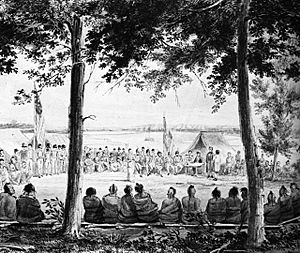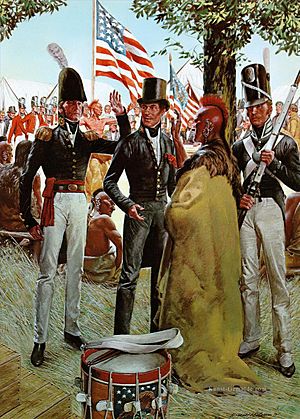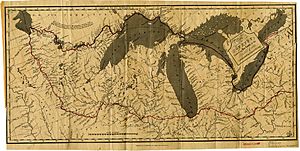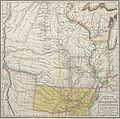Stephen Harriman Long facts for kids
Quick facts for kids
Stephen Harriman Long
|
|
|---|---|
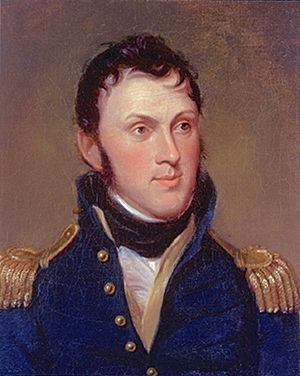
Representation of 1819 oil painting of Major Long. Portrait painted by Charles Willson Peale
|
|
| Born | December 30, 1784 Hopkinton, New Hampshire, U.S.
|
| Died | September 4, 1864 (aged 79) Alton, Illinois, U.S.
|
| Nationality | American |
| Education | Dartmouth College |
| Occupation | Engineer |
| Spouse(s) | Martha Hodgkins |
| Parent(s) | Moses and Lucy (Harriman) Long |
| Engineering career | |
| Discipline | Civil Engineer, Topographical engineer, explorer, inventor. |
| Institutions | US Army Corps of Engineers (1819-38), United States Army Corps of Topographical Engineers (1838-63). |
| Employer(s) | Baltimore and Ohio Railroad, Western & Atlantic Railroad. |
| Projects | Led five expeditions (1817-1823) through the Upper Mississippi Valley and the borderlands with Canada. |
Stephen Harriman Long (born December 30, 1784 – died September 4, 1864) was an American army engineer, explorer, and inventor. He was known for his work on steam locomotives, which are a type of train engine. He was also one of the most active explorers in the early 1800s. Even though his exploring career was short, he traveled over 26,000 miles on five different trips. One of his most famous expeditions was to the Great Plains area. He called this region a "Great Desert," which led to the name "Great American Desert."
Contents
Stephen Long's Early Life and Career
Stephen Long was born in Hopkinton, New Hampshire. His family came from England a long time ago. He went to Dartmouth College and graduated in 1809. In 1814, he joined the U.S. Army Corps of Engineers as a lieutenant. This group of engineers helped build important structures for the country. In 1816, he became a Major and worked as a topographical engineer. This meant he mapped and studied the land.
In 1817, Major Long led a military trip up the Mississippi River to the Falls of St. Anthony. Because of his advice, the Army built Fort Snelling. This fort helped protect settlers in the Upper Mississippi Valley from Native American attacks. Long wrote about his journey in a journal, which was later published as Voyage in a Six-oared Skiff to the Falls of St. Anthony.
In 1819, he married Martha Hodgkiss. Soon after, he led the science team for the Yellowstone Expedition to explore the Missouri River. In 1820, he was chosen to lead another expedition through the American West. The goal was to find where the Platte, Arkansas, and Red rivers started.
Later, in 1823, he led more military trips. These explored the areas near the Canadian border, including the Upper Mississippi Valley, the Minnesota River, and the Red River of the North. During this trip, he helped figure out part of the northern border between the U.S. and Canada.
Stephen Long's Work with Railroads
After his military expeditions, Major Long worked as an engineer for several railroads. He helped survey and build the Baltimore and Ohio Railroad. In 1826, he received his first patent for his ideas on steam locomotives. A patent protects an invention. He got many more patents for locomotive designs. He also worked with other Army engineers to plan and build railroads. Long also invented ways to make wooden bridges stronger.
In 1832, he started a company called the American Steam Carriage Company. However, the company closed in 1834 because it was hard to build his locomotive designs. From 1836 to 1837, Long surveyed a route for a railroad from Belfast, Maine to Quebec. He suggested a good path, but the project stopped due to money problems.
In 1837, Colonel Long took a break from the Army to work for the Western and Atlantic Railroad in Georgia. He was the chief engineer until 1840. He started surveying in July and his plans were followed very closely during construction.
In 1838, he joined the new U.S. Corps of Topographical Engineers. He stayed loyal to the U.S. government during the Civil War. He became a Colonel in 1861. He died in Alton, Illinois in 1864.
Stephen Long's Expeditions
Exploring the Great Plains (1820)
Engineers like Long were trained in college and liked to study the natural world. They also used new technology. Topographical engineers had a special way of looking at things. They focused on geography and technology.
In 1818, Long was asked to organize a science team for the Yellowstone expedition. This trip was meant to explore the upper Missouri River. Long spent time designing an experimental steamboat called Western Engineer. In June 1819, it was the first steamboat to travel up the Missouri River into the Louisiana Purchase. It was also the first steamboat with a paddle wheel at the back. Long's group built their winter camp near Council Bluffs, Iowa, and called it "Engineer Cantonment."
Long soon returned to the East Coast. By May, his plans had changed. The Yellowstone Expedition was very expensive. So, President James Monroe decided Long should lead a new expedition. This trip would go up the Platte River to the Rocky Mountains. Then, it would travel along the border with the Spanish colonies. Exploring this border was important because a new treaty had just set the U.S. border to the Pacific Ocean.
Major Long led the first scientific trip up the Platte River. The goal was to study the land and its natural resources. His group of 19 men included artists and scientists. They included Samuel Seymour (a painter), Titian Peale (a naturalist painter), Thomas Say (a zoologist), and Edwin James (a doctor who knew about geology and plants). Edwin James was the first person to climb Pikes Peak on this trip.
On June 6, 1820, they traveled up the Platte River. They met Pawnee and Otoe Indians. On October 14, 1820, 400 Omaha people met with Long. Their chief, Big Elk, gave a speech. He said that his people loved the white people. He also said that he knew the land would not be good for farmers because there wasn't enough wood.
Long wrote that the Pawnee people were "respectable." After finding and naming Longs Peak and the Rocky Mountains, they went to the Arkansas River area. The expedition then split up. Long led his group towards the Red River. They missed it and met some unfriendly Native Americans. They even had to eat their own horses to survive. Finally, they met the other part of the expedition at Fort Smith, Arkansas.
The "Great Desert" Report
In his report about the 1820 expedition, Long wrote that the Plains from Nebraska to Oklahoma were "unfit for cultivation." This meant they were not good for farming. He also said they were "uninhabitable" for people who relied on farming. On his map, he called this area a "Great Desert."
Long thought this "Great Desert" could be a barrier. It would protect the U.S. from the Spanish, British, and Russians who also lived on the continent. He also believed that the eastern part of the country, which had forests, should be fully settled first. He thought sending settlers to the "Great Desert" was not a good idea.
Given the technology of the 1820s, Long was right. There was little wood for houses or fires. There was not much surface water, and the soil was sandy. Winters were harsh. There were huge herds of bison and sometimes unfriendly Native Americans. Also, there were no easy ways to communicate.
However, it's interesting that Native American tribes had lived there for centuries. By the end of the 1800s, the "Great Desert" became a major farming area for the country.
This expedition had two main results. First, it gave a very accurate description of Native American customs and life among the Omaha, Otoes, and Pawnees. Second, it described the land west of the Missouri River as a "desert."
Exploring the Red River of the North (1823)
Major Long's 1823 expedition went up the Minnesota River (then called St. Peter's River). They went to where the Red River of the North begins. Then, they traveled down that river to Pembina and Fort Garry. From there, they went by canoe across British Canada to Lake Huron.
This trip is sometimes confused with his earlier expedition to the Red River in Texas and Oklahoma. The 1823 trip was a separate journey. It was part of a series of explorations planned by Lewis Cass. The main goals of the 1823 expedition were scientific study and checking out trade possibilities. It also likely had secret military goals. British officials in Canada were suspicious of the trip.
This expedition helped encourage American traders to get involved in the fur trade in Northern Minnesota and Dakota. It also led to the development of the Red River Trails. These trails were used for trade with ox carts between the Red River Colony and Fort Garry.
Marine Hospitals and Napoleon, Arkansas
In 1837, the U.S. Congress approved building seven Marine Hospitals. These hospitals were for sailors. Long was asked to build the first hospital in Louisville, Kentucky. Construction was delayed until after the Mexican War. Work finally began in late 1845.
While finishing the Louisville hospital, Long also started building similar hospitals in Paducah, Kentucky; Natchez, Louisiana; and Napoleon, Arkansas. These hospitals were designed by Robert Mills, who also designed the Washington Monument.
Long was asked to build the hospital in Napoleon, Arkansas, in 1849. Napoleon was located at the mouth of the Arkansas River. Long surveyed the area and warned against building there. He said the town was likely to flood and be destroyed by the Mississippi and Arkansas Rivers. He suggested Helena, Arkansas, as a better place.
In early 1850, Long's warnings were ignored. Construction was ordered to begin without delay. Long asked for money to start building, but flooding caused delays. Work finally started in August. Delays continued due to floods and sickness. The hospital was finally finished in August 1854. It started taking patients in 1855.
The city of Napoleon was burned in 1862 during the Civil War, but the hospital survived. However, the hospital did not last long. Long's predictions were correct. By March 11, 1868, the river had eroded the land to within 52 feet of the hospital. Less than a month later, a corner of the hospital fell into the Mississippi River. The entire town of Napoleon was swallowed by the river 28 years after Long first warned against building there.
Of all the Marine Hospitals Long oversaw, only the one in Louisville, Kentucky, still stands today.
See also
 In Spanish: Stephen Harriman Long para niños
In Spanish: Stephen Harriman Long para niños
- New Hampshire Historical Marker No. 179: Smith Bridge
- New Hampshire Historical Marker No. 196: Blair Bridge
Images for kids
Research resources
- The Journal of Captain John R. Bell: official journalist for the Stephen H. Long Expedition to the Rocky Mountains: http://www.oac.cdlib.org/findaid/ark:/13030/tf55800408 (1 folder) is housed in the Department of Special Collections and University Archives at Stanford University Libraries


